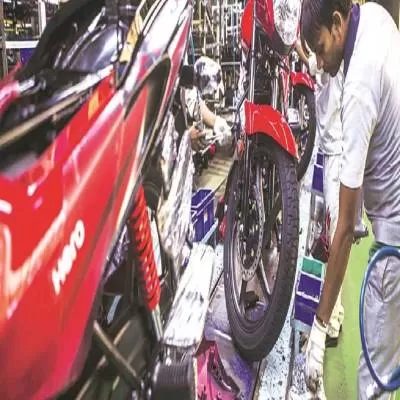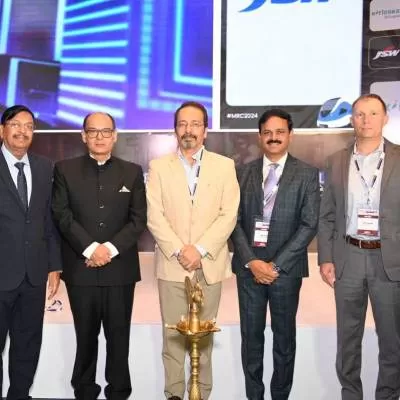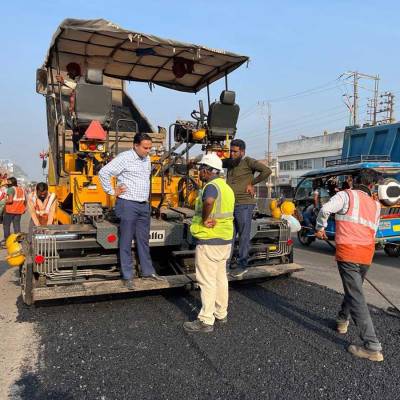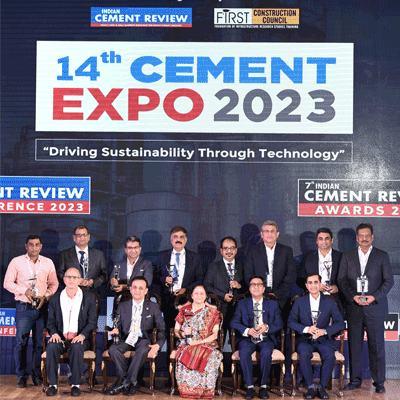- Home
- Building Material
- Cement
- Clusters call
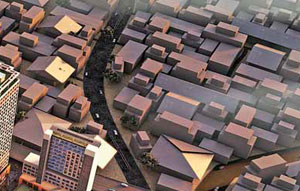
Clusters call
Today, Mumbai's 100-year-old Bhendi Bazaar, a place rich in history and culture, once considered among the liveliest local shopping destinations, is in a dilapidated shape. Eighty per cent of the buildings have been declared unfit for living. The majority of the population lives in households of less than 300 sq ft. The roads are narrow and congested; conditions are squalid, sanitation facilities are poor, and there is no parking.
Tomorrow is likely to be different - and how! A well-planned residential locality with modern buildings, wide roads, better infrastructure, open spaces and a contemporary commercial space spread across 16.5 acre. Encompassing 3,200 homes in 250 existing buildings and 1,250 businesses, touching the lives of 20,000 people, this is the master plan for Bhendi Bazaar's redevelopment.
"The intent of cluster redevelopment is to remake a city like Mumbai that has remained untouched over the years," says Abbas Master, CEO, Saifee Burhani Upliftment Trust, a public charitable trust formed to redevelop Bhendi Bazaar. In fact, the city is home to over 90,000 buildings that are now in poor condition. "In older locations and developments, there is a peculiar problem," says Gulam M Zia, Executive Director, Advisory, Retail and Hospitality, Knight Frank India. "The structures are old, but because the sizes are small, they are not economically viable for redevelopment." The answer to such a problem is cluster redevelopment, which is now being adopted in Mumbai.
In the view of Nishant Kailash Agarwal, Managing Director, Avighna India Ltd, cluster redevelopment is the need of the hour across the country. "In most metros - Delhi, Kolkata, Bengaluru - there are a lot of old structures in the centre of the city that require redevelopment," he points out. "For this, there is no better way than cluster."
His project, One Avighna Park in Mumbai, is a case in point where a dilapidated mill with 85 warehouses is being redeveloped into a multi-storeyed residential project.
The challenge
The concept of cluster redevelopment is not a simple one, though. As Dr Prem C Jain, Chairman, Indian Green Building Council, and Chairman, AECOM India, says, "Infrastructure is the biggest challenge as some places are inaccessible." If the connected infrastructure is not adequate, it is not possible to upgrade. "As you don't have a greenfield area, you need to play within the constraints," says Pankaj Kapoor, Founder & Managing Director, Liases Foras Real Estate Rating and Research PL. "Although there are a lot of design challenges, this is a highly creative subject."
Further, redeveloping an existing area is about upgrading houses as well as uplifting the overall thinking of people. Speaking from his experience at the Bhendi Bazaar project, Qutub Mandviwala, Principal Architect, Mandviwala Qutub & Associates, says, "The brief is partly set by the people already residing there and existing amenities, like religious places." He believes adding density to a new system and introducing new factors while preserving the existing character and vibrancy of the place is a big challenge.
The process
"One of the main criteria for the project to take off as per Maharashtra's Development Control Rules (DCR) 33(7) is that the developer should have 100 per cent owner and 70 per cent tenant consent," says Master, citing that the recently proposed policy by the state, DCR 33(9), which is in consideration, requires 70 per cent tenant and owner consent. Post this, the developer submits the proposal to the high power committee, which approves and recommends it to the state government's UD Department. The UD Department then gets a sign-off from the chief minister, and the regular round of approvals begin. It is time consuming, one reason why many developers are shying away from it.
Meanwhile, MK Thombre, Chief Officer, Maharashtra Buildings Repairs and Reconstruction Board (MBRRB), Maharashtra Housing and Area Development Authority (MHADA), highlights the salient features of Maharashtra's revised Cluster Redevelopment Policy's DCR 33(9): The area should be about 4,000 sq m and more. The developer gets 4 FSI as incentive as against the general FSI of 1.73 in Mumbai. He has to rehabilitate the tenants, giving each one a minimum 300 sq ft carpet area or the area which the tenant is in possession. Also, if there is government land in the 4,000 sq m, the concerned government agency needs to give its consent as well.
"Redevelopment in the past six to seven years has been moving at snail's pace, with FSI being one issue," affirms Kapoor. "But cluster redevelopment has helped increase FSI, urging developers to see greater viability in these projects."
However, though it may be considered that cluster redevelopment under Maharashtra's DCR 33(9) with FSI of 4 gives more benefit to developers, some industry experts do not agree. Nor does this hold true for DCR 33(7) - the previous policy - with FSI of 3. (The table next page explains the difference between DCR 33(7) and the existing DCR 33(9).)
Money matters
Money, as always, is a factor as well. In Mumbai, many perceive the concept of cluster redevelopment to be cost-intensive and not feasible. Apart from construction cost, there are additional and hidden costs for developers invested in free housing, rental, etc. Moreover, there could be land parcels that are not attractive. Stating that "The government has to offer more incentives," Agarwal points out the fact that return on investment does not exist today, which is a key problem.
"If I were to do a DCR 33(7) project, I can choose the area for development, which will benefit me," he reasons. "However, in the revised scheme, I have to consider the plots from which I can not earn as well."
For his part, though, Dr Jain says, "The money spent on the entire development of the cluster can be derived from the commercial buildings." Further, some researchers and consultants believe that in terms of cash flow, cluster redevelopment projects work better. "It is not cost-intensive if compared to a greenfield acquisition," says Zia. Kapoor agrees with him, saying that where land has become very unproductive, redevelopment is a better option. "Instead of purchasing land and doing a project on it, if you do a redevelopment project today, it increases your return on equities by 120 per cent. So, the profitability is quite good."
What's more, One Avighna Park and Bhendi Bazaar, future trendsetters in India for cluster redevelopment, have set a green footprint as well. "Being built green, 3 per cent of additional construction cost has been involved with a payback period of less than three years for the Bhendi Bazaar project," shares Dr Jain. In this way, developers can get returns in the form of payback, especially from the commercial set up.
And finally
All considered then, is there a future for cluster redevelopment in India?
"Cities like Mumbai, Chennai and Delhi have been developed haphazardly without considering traffic," says Dr Jain. "Cluster development should be looked at as an amazing opportunity. Agarwal is even more emphatic, telling us, "Cluster is the only way to progress for India, provided one understands the framework."
For his part, Zia says, "This is feasible for developers in other cities as well." And looking ahead, Mandviwala recommends, "To eventually create a better skyline, the government should research and earmark clusters, ensuring a balance as long as the densities go." Well, the eyes appear to have it! Evidently, as a process for problem solving and urban renewal, cluster redevelopment is here to stay.
T Nagar, Chennai: Constructed between 1923 and 1925 by the Madras Presidency Government as a part of town planning activity and conceived as a residential locality, it is now one of the city's principal shopping districts.
Chandni Chowk, Delhi: Built in 1650s and originally housing about 1,560 shops and porticos, this is one of the oldest and busiest markets in Old Delhi. A redevelopment plan can give this place a new and unique look.
Shah Ali Banda, Hyderabad: Forming a part of the old city area and located close to Charminar, this is one of the oldest suburbs in Hyderabad.
Beyond Mumbai: Some potential clusters in India
Hyderabad
- Malakpet
- Nampally
- Mehdipatnam
- Shah Ali Banda
Delhi
- Chandni Chowk Nai Sarak
- Janakpuri
- Greater Kailash II
- Karol Baug
- Lajpat Nagar
- Kidwai Nagar
Kolkata
- Sovabazar Hatibagan
- Bagbazar
- Belgachhia
- Jadavpur Police Area
- Talegaon
- Alipur
- Behala
- Ruby Hospital bypass
- Shyambazar
Bengaluru
- Old Chikpet
- Binnipet
- Shivaji Nagar
- Chamrajpet
Chennai
- T Nagar Parry's Corner
- Washermenpet
- Tondiarpet
Ravi Saund, COO, CHD Developers
"Cluster redevelopment is a highly consumer-friendly move as it reduces costs for the developer, which can be passed on; however, the benefits of the same can only be realised in Western India. Northern India, by virtue of space, is still to realise a lot of vertical development. In the years to come, regulation in such policies will be the need of the hour."
Harshavardhan Neotia, Chairman, Ambuja Neotia Group
"Kolkata is an old city with heritage structures that can be revived. But this will certainly involve many legal challenges. Cluster redevelopment is not a vanilla development that is relatively simpler as it involves a long process and convincing multiple tenancies. Having done restoration of old buildings at an individual level, in principle, we will certainly be interested if there is an opportunity in cluster redevelopment."
T Chitty Babu, Chairman & CEO, Akshaya Pvt Ltd
"Compared to Mumbai, in Chennai one can not easily get large land parcels for redevelopment. If given an opportunity, we would bet big on cluster redevelopment projects as these do not necessarily have to be executed in a sell-and-move model but could be a build-and-retain model, built-and-lease model, build-and-exit model, etc."
"Cluster redevelopment is a term very unique to India."
Speaking from his experience of preparing the master plan for India's largest cluster redevelopment project, Mumbai's Bhendi Bazaar, Roland Baer, Principal, Perkins Eastman, shares his perspective...
Global glimpse: Internationally, we have developed existing neighbourhoods, as compared to Bhendi Bazaar, where we are integrating the existing and the new. I have done projects in China and considering the FSI and area for office space, we develop what we think the market can bear. But in the case of Bhendi Bazaar, we have to replace. In a country like China, there is some consensus making, but it is not by the majority. However, in the case of India, especially Maharashtra's policy, you need almost 100 per cent consensus from the tenants.
India calling: Cluster redevelopment provides an opportunity to rebuild high density urban areas that have been difficult to organise and/or acquire. It is an opportunity to help re-plan a large section of older cities throughout the country. This will create the opportunity for developers to build in areas that were previously inaccessible.
Challenges in India: India is the largest democracy in the world and it is not exactly the easiest one to get through. A major challenge is to get the sign-off from a huge number of tenants and projects like Bhendi Bazaar have actually achieved this. As consultants, we have considered making adjustments to the master plan depending on changed requirements, new additions, etc.
To share your views on the potential for cluster redevelopment in India, write in at feedback@ASAPPmedia.com
Although at its nascent stage in India, cluster redevelopment is the ideal way to progress in future, discovers SHRIYAL SETHUMADHAVAN. Today, Mumbai's 100-year-old Bhendi Bazaar, a place rich in history and culture, once considered among the liveliest local shopping destinations, is in a dilapidated shape. Eighty per cent of the buildings have been declared unfit for living. The majority of the population lives in households of less than 300 sq ft. The roads are narrow and congested; conditions are squalid, sanitation facilities are poor, and there is no parking. Tomorrow is likely to be different - and how! A well-planned residential locality with modern buildings, wide roads, better infrastructure, open spaces and a contemporary commercial space spread across 16.5 acre. Encompassing 3,200 homes in 250 existing buildings and 1,250 businesses, touching the lives of 20,000 people, this is the master plan for Bhendi Bazaar's redevelopment. The intent of cluster redevelopment is to remake a city like Mumbai that has remained untouched over the years, says Abbas Master, CEO, Saifee Burhani Upliftment Trust, a public charitable trust formed to redevelop Bhendi Bazaar. In fact, the city is home to over 90,000 buildings that are now in poor condition. In older locations and developments, there is a peculiar problem, says Gulam M Zia, Executive Director, Advisory, Retail and Hospitality, Knight Frank India. The structures are old, but because the sizes are small, they are not economically viable for redevelopment. The answer to such a problem is cluster redevelopment, which is now being adopted in Mumbai. In the view of Nishant Kailash Agarwal, Managing Director, Avighna India Ltd, cluster redevelopment is the need of the hour across the country. In most metros - Delhi, Kolkata, Bengaluru - there are a lot of old structures in the centre of the city that require redevelopment, he points out. For this, there is no better way than cluster. His project, One Avighna Park in Mumbai, is a case in point where a dilapidated mill with 85 warehouses is being redeveloped into a multi-storeyed residential project. The challenge The concept of cluster redevelopment is not a simple one, though. As Dr Prem C Jain, Chairman, Indian Green Building Council, and Chairman, AECOM India, says, Infrastructure is the biggest challenge as some places are inaccessible. If the connected infrastructure is not adequate, it is not possible to upgrade. As you don't have a greenfield area, you need to play within the constraints, says Pankaj Kapoor, Founder & Managing Director, Liases Foras Real Estate Rating and Research PL. Although there are a lot of design challenges, this is a highly creative subject. Further, redeveloping an existing area is about upgrading houses as well as uplifting the overall thinking of people. Speaking from his experience at the Bhendi Bazaar project, Qutub Mandviwala, Principal Architect, Mandviwala Qutub & Associates, says, The brief is partly set by the people already residing there and existing amenities, like religious places. He believes adding density to a new system and introducing new factors while preserving the existing character and vibrancy of the place is a big challenge. The process One of the main criteria for the project to take off as per Maharashtra's Development Control Rules (DCR) 33(7) is that the developer should have 100 per cent owner and 70 per cent tenant consent, says Master, citing that the recently proposed policy by the state, DCR 33(9), which is in consideration, requires 70 per cent tenant and owner consent. Post this, the developer submits the proposal to the high power committee, which approves and recommends it to the state government's UD Department. The UD Department then gets a sign-off from the chief minister, and the regular round of approvals begin. It is time consuming, one reason why many developers are shying away from it. Meanwhile, MK Thombre, Chief Officer, Maharashtra Buildings Repairs and Reconstruction Board (MBRRB), Maharashtra Housing and Area Development Authority (MHADA), highlights the salient features of Maharashtra's revised Cluster Redevelopment Policy's DCR 33(9): The area should be about 4,000 sq m and more. The developer gets 4 FSI as incentive as against the general FSI of 1.73 in Mumbai. He has to rehabilitate the tenants, giving each one a minimum 300 sq ft carpet area or the area which the tenant is in possession. Also, if there is government land in the 4,000 sq m, the concerned government agency needs to give its consent as well. Redevelopment in the past six to seven years has been moving at snail's pace, with FSI being one issue, affirms Kapoor. But cluster redevelopment has helped increase FSI, urging developers to see greater viability in these projects. However, though it may be considered that cluster redevelopment under Maharashtra's DCR 33(9) with FSI of 4 gives more benefit to developers, some industry experts do not agree. Nor does this hold true for DCR 33(7) - the previous policy - with FSI of 3. (The table next page explains the difference between DCR 33(7) and the existing DCR 33(9).) Money matters Money, as always, is a factor as well. In Mumbai, many perceive the concept of cluster redevelopment to be cost-intensive and not feasible. Apart from construction cost, there are additional and hidden costs for developers invested in free housing, rental, etc. Moreover, there could be land parcels that are not attractive. Stating that The government has to offer more incentives, Agarwal points out the fact that return on investment does not exist today, which is a key problem. If I were to do a DCR 33(7) project, I can choose the area for development, which will benefit me, he reasons. However, in the revised scheme, I have to consider the plots from which I can not earn as well. For his part, though, Dr Jain says, The money spent on the entire development of the cluster can be derived from the commercial buildings. Further, some researchers and consultants believe that in terms of cash flow, cluster redevelopment projects work better. It is not cost-intensive if compared to a greenfield acquisition, says Zia. Kapoor agrees with him, saying that where land has become very unproductive, redevelopment is a better option. Instead of purchasing land and doing a project on it, if you do a redevelopment project today, it increases your return on equities by 120 per cent. So, the profitability is quite good. What's more, One Avighna Park and Bhendi Bazaar, future trendsetters in India for cluster redevelopment, have set a green footprint as well. Being built green, 3 per cent of additional construction cost has been involved with a payback period of less than three years for the Bhendi Bazaar project, shares Dr Jain. In this way, developers can get returns in the form of payback, especially from the commercial set up. And finally All considered then, is there a future for cluster redevelopment in India? Cities like Mumbai, Chennai and Delhi have been developed haphazardly without considering traffic, says Dr Jain. Cluster development should be looked at as an amazing opportunity. Agarwal is even more emphatic, telling us, Cluster is the only way to progress for India, provided one understands the framework. For his part, Zia says, This is feasible for developers in other cities as well. And looking ahead, Mandviwala recommends, To eventually create a better skyline, the government should research and earmark clusters, ensuring a balance as long as the densities go. Well, the eyes appear to have it! Evidently, as a process for problem solving and urban renewal, cluster redevelopment is here to stay. T Nagar, Chennai: Constructed between 1923 and 1925 by the Madras Presidency Government as a part of town planning activity and conceived as a residential locality, it is now one of the city's principal shopping districts. Chandni Chowk, Delhi: Built in 1650s and originally housing about 1,560 shops and porticos, this is one of the oldest and busiest markets in Old Delhi. A redevelopment plan can give this place a new and unique look. Shah Ali Banda, Hyderabad: Forming a part of the old city area and located close to Charminar, this is one of the oldest suburbs in Hyderabad. Beyond Mumbai: Some potential clusters in India Hyderabad Malakpet Nampally Mehdipatnam Shah Ali Banda Delhi Chandni Chowk Nai Sarak Janakpuri Greater Kailash II Karol Baug Lajpat Nagar Kidwai Nagar Kolkata Sovabazar Hatibagan Bagbazar Belgachhia Jadavpur Police Area Talegaon Alipur Behala Ruby Hospital bypass Shyambazar Bengaluru Old Chikpet Binnipet Shivaji Nagar Chamrajpet Chennai T Nagar Parry's Corner Washermenpet Tondiarpet Ravi Saund, COO, CHD Developers Cluster redevelopment is a highly consumer-friendly move as it reduces costs for the developer, which can be passed on; however, the benefits of the same can only be realised in Western India. Northern India, by virtue of space, is still to realise a lot of vertical development. In the years to come, regulation in such policies will be the need of the hour. Harshavardhan Neotia, Chairman, Ambuja Neotia Group Kolkata is an old city with heritage structures that can be revived. But this will certainly involve many legal challenges. Cluster redevelopment is not a vanilla development that is relatively simpler as it involves a long process and convincing multiple tenancies. Having done restoration of old buildings at an individual level, in principle, we will certainly be interested if there is an opportunity in cluster redevelopment. T Chitty Babu, Chairman & CEO, Akshaya Pvt Ltd Compared to Mumbai, in Chennai one can not easily get large land parcels for redevelopment. If given an opportunity, we would bet big on cluster redevelopment projects as these do not necessarily have to be executed in a sell-and-move model but could be a build-and-retain model, built-and-lease model, build-and-exit model, etc. Cluster redevelopment is a term very unique to India. Speaking from his experience of preparing the master plan for India's largest cluster redevelopment project, Mumbai's Bhendi Bazaar, Roland Baer, Principal, Perkins Eastman, shares his perspective... Global glimpse: Internationally, we have developed existing neighbourhoods, as compared to Bhendi Bazaar, where we are integrating the existing and the new. I have done projects in China and considering the FSI and area for office space, we develop what we think the market can bear. But in the case of Bhendi Bazaar, we have to replace. In a country like China, there is some consensus making, but it is not by the majority. However, in the case of India, especially Maharashtra's policy, you need almost 100 per cent consensus from the tenants. India calling: Cluster redevelopment provides an opportunity to rebuild high density urban areas that have been difficult to organise and/or acquire. It is an opportunity to help re-plan a large section of older cities throughout the country. This will create the opportunity for developers to build in areas that were previously inaccessible. Challenges in India: India is the largest democracy in the world and it is not exactly the easiest one to get through. A major challenge is to get the sign-off from a huge number of tenants and projects like Bhendi Bazaar have actually achieved this. As consultants, we have considered making adjustments to the master plan depending on changed requirements, new additions, etc. To share your views on the potential for cluster redevelopment in India, write in at feedback@ASAPPmedia.com





